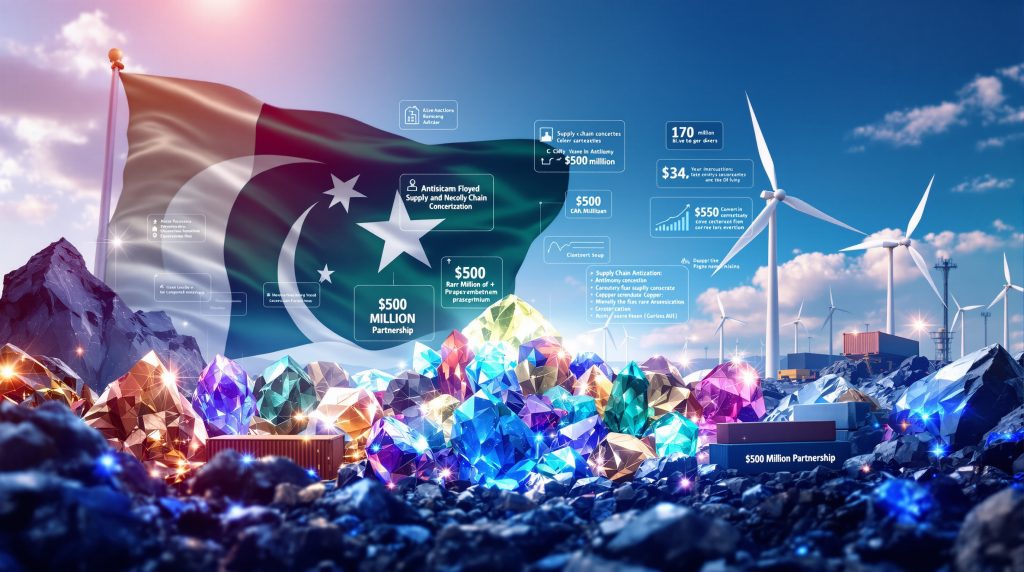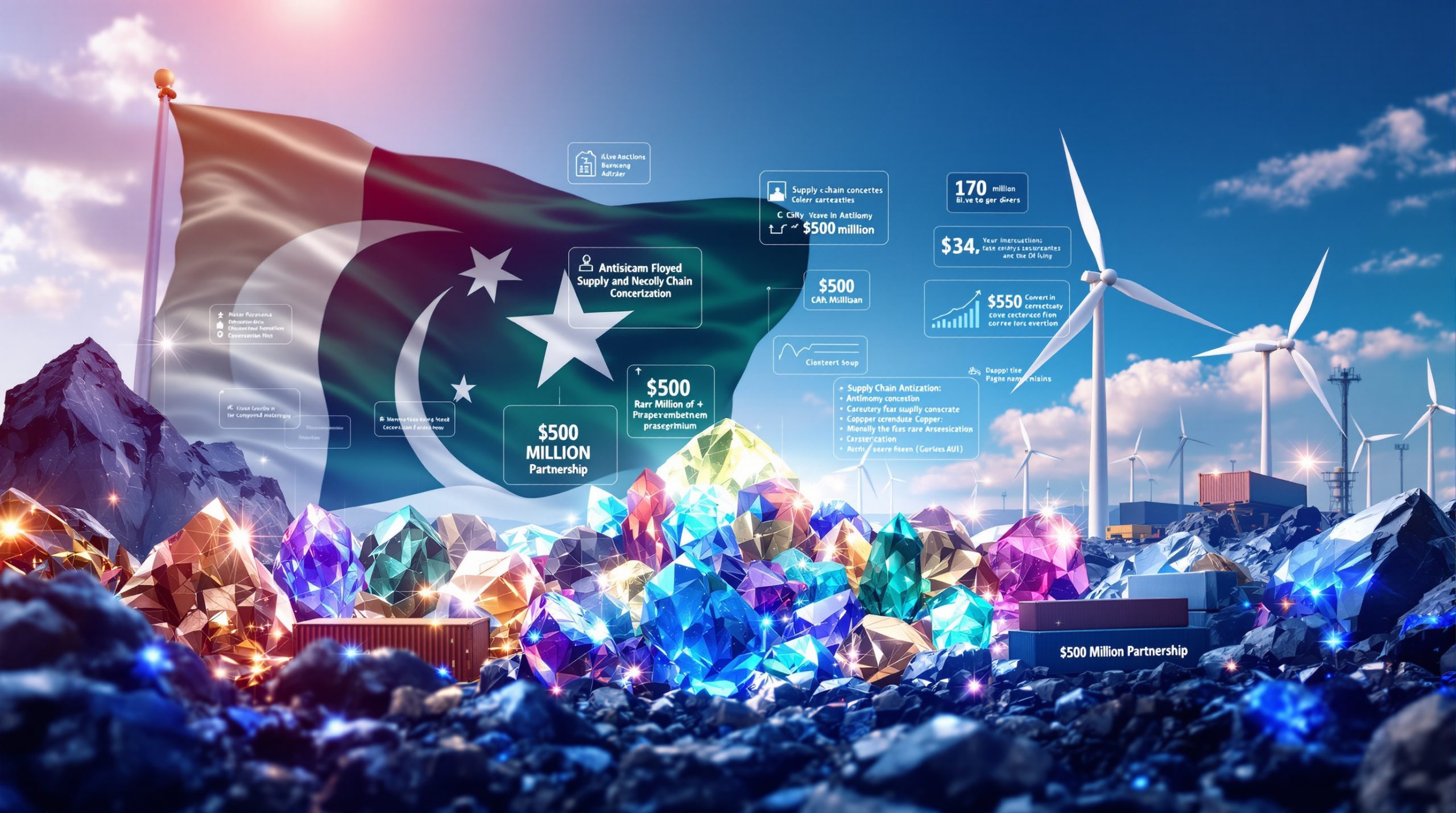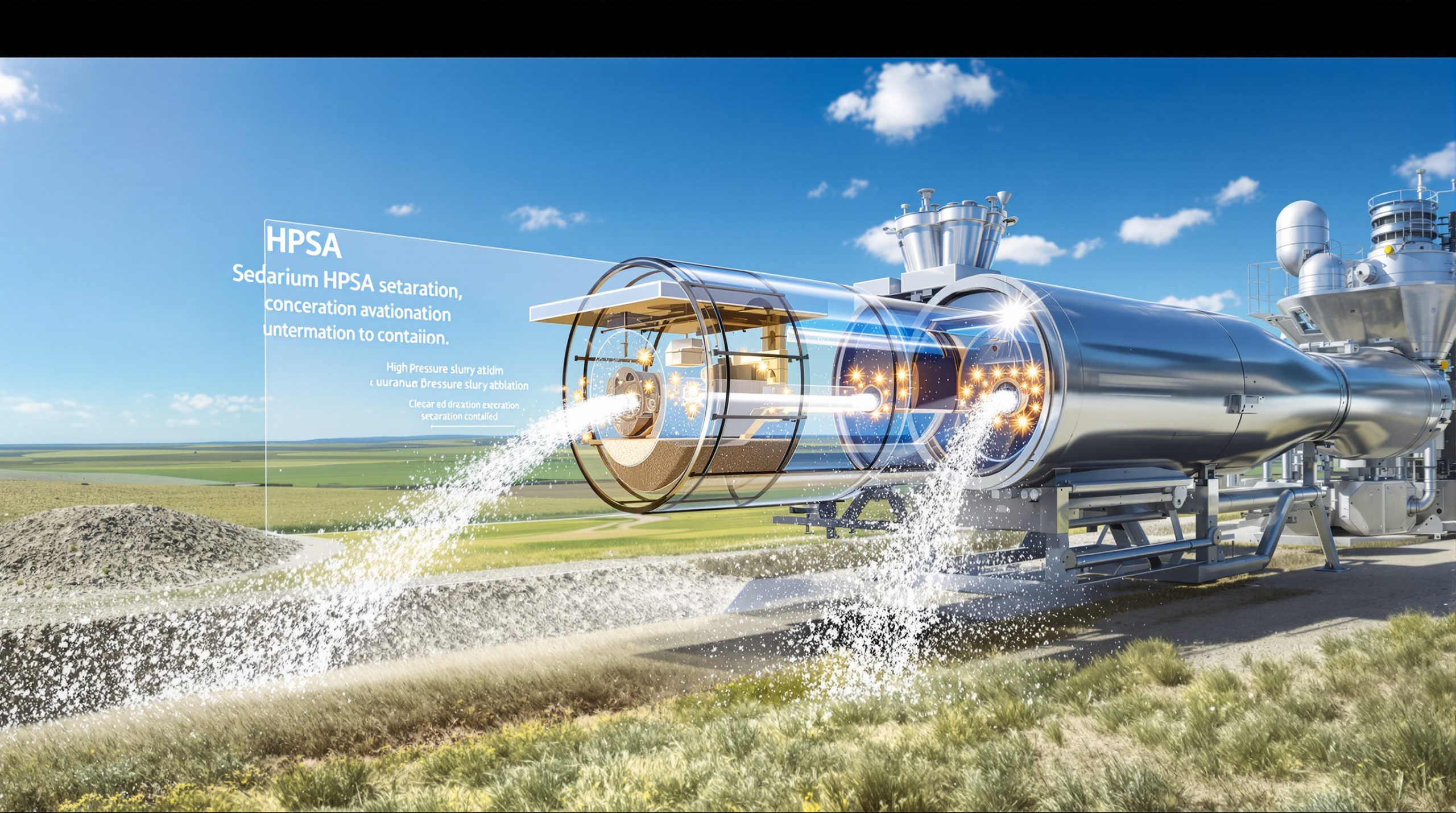Understanding the Pakistan-US Critical Minerals Partnership
Landmark $500 Million Partnership Framework
The Pakistan-US critical minerals partnership represents a historic development in global mineral supply chains. Established in September 2025, this groundbreaking collaboration marks the first-ever delivery of rare earth elements and critical minerals from Pakistan to the United States. On September 8, 2025, Pakistan and US Strategic Metals (USSM) formalized their commitment by signing two memorandums of understanding, creating a comprehensive framework for joint development across the entire mineral value chain.
The inaugural shipment, delivered in October 2025, included strategic resources such as strategic antimony investment, copper concentrate, and rare earth elements—specifically neodymium and praseodymium. This milestone delivery officially launched the $500 million partnership framework designed to develop extensive capabilities from initial exploration to refinery operations within Pakistan.
Prime Minister Shehbaz Sharif highlighted the significance of this collaboration, emphasizing Pakistan's emergence as "a credible and trusted partner in building secure and diversified supply chains for the future of our two nations." This sentiment was echoed by US Embassy chargé d'affaires in Islamabad, Natalie Baker, who expressed enthusiasm for "future agreements between US companies and their counterparts in the critical minerals and mining sector in Pakistan."
Geopolitical Significance in Global Mineral Security
The timing of this partnership carries profound geopolitical implications amid escalating concerns about mineral supply security. As China implements increasingly restrictive export controls on critical minerals, the United States has actively pursued diversification strategies to reduce vulnerability in its supply chains. Pakistan's emergence as a reliable partner provides the US with an alternative source for materials deemed essential for advanced manufacturing, defense applications, and the critical minerals energy transition.
This collaboration aligns perfectly with the US Department of Energy's mineral security initiatives, as evidenced by its August 2025 announcement to issue notices for nearly $1 billion in funding opportunities specifically designed to advance mining, processing, and manufacturing technologies across critical mineral supply chains.
The partnership represents a strategic pivot in US critical minerals policy, moving away from overdependence on dominant suppliers toward a more resilient network of trusted international partners—a concept often referred to as "friend-shoring" in supply chain security discussions.
How This Partnership Addresses Global Critical Mineral Challenges
Current Global Supply Constraints
The global supply landscape for critical minerals faces unprecedented challenges, with China maintaining a dominant position across several crucial resources. According to the US Geological Survey (USGS) data from 2023, China controls approximately 48% of global antimony mine production—a startling concentration that creates significant supply vulnerabilities.
This dominance has been leveraged through export restrictions, resulting in a dramatic 90.5% year-on-year reduction in Chinese antimony exports between January and August 2025 compared to the same period in 2024. Market participants report extreme difficulty in securing supplies, with one trader noting in September 2025 that Chinese exporters have "no appetite to export" and enforce a "strict rule – no materials to Europe or the US."
The severity of supply constraints is further illustrated by the complete absence of domestic production in the United States, with USGS reporting that "no marketable antimony was mined" in the US during 2023. This supply shortage has driven prices to premium levels, with Fastmarkets assessing antimony trioxide (99.5% Sb2O3 min) at $24-26 per pound as of October 1, 2025.
The US Department of Energy highlighted these challenges in an August 13 notice, stating that "gallium, germanium, indium compounds, antimony and bismuth are all small market materials with nearly 100% dependence on foreign by-product recovery."
Pakistan's Emerging Role in Mineral Markets
Pakistan stands poised to fundamentally reshape global mineral markets, with estimates suggesting the country possesses up to $6 trillion in rare earth mineral reserves. This vast resource base positions Pakistan as potentially one of the most significant alternative suppliers in global markets, particularly for elements critical to clean energy technologies and advanced manufacturing.
The partnership with USSM provides Pakistan with vital technical expertise and market access needed to develop its mineral wealth responsibly and efficiently. USSM CEO Stacy W. Hastie emphasized the long-term vision behind this collaboration, describing it as "the first step in our exciting journey together with the Frontier Works Organization of Pakistan, to provide critical minerals to the United States and bolster economic trade and friendship between our two countries."
By focusing initially on strategic minerals including antimony and rare earth elements, Pakistan is targeting resources with immediate market demand and significant supply constraints. This approach allows for rapid development of specific value chains while building the expertise and infrastructure needed for broader mineral sector growth.
Economic Benefits of the Pakistan-US Minerals Partnership
Investment and Development Opportunities
The $500 million investment framework established between Pakistan and USSM lays the groundwork for transformative economic development within Pakistan's mining sector. This substantial financial commitment spans the entire value chain—from initial exploration activities to concentrate production and, eventually, the establishment of domestic refining operations.
This comprehensive approach to mineral development creates multi-layered economic benefits beyond simple resource extraction. By developing processing capabilities within Pakistan rather than exporting raw materials, the country can capture significantly more value from its mineral wealth while creating higher-skilled employment opportunities throughout the supply chain.
The development of Pakistan's mining sector brings potential for substantial job creation across multiple skill levels—from geological exploration teams to processing facility operators and logistics specialists. Additionally, the technical collaboration with USSM facilitates critical knowledge transfer in mining techniques, mineral processing technologies, and quality assurance systems.
Market Access and Trade Enhancement
The direct supply relationship with USSM provides Pakistan with unprecedented access to the US market for strategic minerals—opening doors to premium pricing for these in-demand resources. As global competition for secure mineral supplies intensifies, Pakistan's early-mover advantage in establishing this relationship positions it favorably in international markets.
This partnership significantly diversifies Pakistan's export portfolio beyond traditional commodities, adding high-value mineral products to its international trade. The focus on minerals essential to clean energy technologies and advanced manufacturing aligns Pakistan's export strategy with growing global demand sectors.
Beyond the immediate economic benefits of mineral exports, this relationship establishes foundations for deeper trade connections between Pakistan and the United States. The initial focus on raw materials creates opportunities to develop more sophisticated trading relationships across the wider economy as trust and cooperation strengthen between the two nations.
Minerals Central to the Pakistan-US Partnership
Strategic Focus on Rare Earth Elements
The inaugural mineral shipment from Pakistan to the US included neodymium and praseodymium—two rare earth elements absolutely critical to modern technology and the clean energy transition. These elements serve as essential components in the powerful permanent magnets used in electric vehicle motors, wind turbine generators, and numerous high-tech applications.
Global demand for these elements is projected to grow exponentially as the world accelerates its transition to clean energy systems. The International Energy Agency estimates that achieving global climate goals could increase demand for rare earth elements by 6-7 times by 2040, creating urgent supply challenges that the Pakistan-US partnership directly addresses.
What makes these particular rare earth elements so valuable is their irreplaceability in many applications—no viable substitutes exist that can deliver comparable performance in permanent magnets. This technical reality makes securing supply chains for these elements a matter of strategic importance for advanced economies.
Critical Industrial Minerals
Antimony represents another focal point of the Pakistan-US partnership, with this mineral included in the first shipment. Though less widely known than rare earths, antimony serves vital functions across multiple industries—from flame retardants in furniture and building materials to crucial components in lead-acid batteries and semiconductor manufacturing.
Defense applications further elevate antimony's strategic importance, as it's used in ammunition, infrared detection devices, and night vision equipment. The mineral's significance to national security underscores why establishing reliable supply chains outside dominant producers has become a priority for the United States.
Copper concentrate, also included in the initial shipment, represents a fundamental building block of electrical infrastructure and clean energy systems. As electrification accelerates globally, copper demand is projected to grow substantially, with the metal playing irreplaceable roles in everything from electrical transmission lines to the windings in electric motors.
The initial focus on these specific minerals suggests a strategic prioritization of resources with both immediate market value and long-term demand growth potential. Future development could potentially expand to other critical minerals like lithium, cobalt, and graphite—all listed in the critical minerals strategy and essential to battery technologies and energy storage systems.
Global Context: Comparing the Pakistan-US Partnership to Other Mineral Initiatives
Emerging Alternative Supply Networks
The Pakistan-US minerals partnership joins a growing network of similar arrangements between the United States and trusted allies aimed at securing critical mineral supply chains. This partnership shares strategic objectives with established collaborations between the US and countries like Australia, Canada, Japan and the European Union—all designed to create resilient supply alternatives to dominant producers.
These collaborative initiatives represent a broader "friend-shoring" strategy gaining momentum across critical supply chains. Rather than pursuing complete self-sufficiency (which is often economically and geologically impractical), this approach focuses on developing supply networks among trusted partners with shared values and interests.
The Pakistan partnership emerges alongside China's expansive Belt and Road mineral initiatives, which have established significant Chinese influence over mineral resources across parts of Africa, Southeast Asia, and Latin America. The competing approaches highlight fundamentally different philosophies to mineral development and international cooperation.
Within South Asia specifically, this partnership positions Pakistan as a regional leader in mineral development and international collaboration. The framework established could serve as a template for similar arrangements with other mineral-rich nations in the region, creating coordinated approaches to responsible resource development.
Unique Elements of the Pakistan-US Approach
What distinguishes the Pakistan-US minerals partnership from many similar arrangements is its comprehensive value chain approach. Rather than focusing solely on mining and extraction, the agreement explicitly covers the entire process through to refining operations—creating a more integrated and value-added relationship.
The emphasis on developing local processing capabilities represents another distinctive element. Instead of establishing Pakistan merely as a source of raw materials, the partnership aims to build domestic capacity for value-added processing—allowing Pakistan to capture more economic benefit from its mineral wealth while creating higher-skilled employment opportunities.
The framework's specific focus on technology transfer and capacity building creates long-term sustainable development rather than simple resource extraction. This approach helps build Pakistan's indigenous capabilities in the mineral sector, reducing dependence on external expertise over time.
The partnership also employs an innovative government-to-business collaboration model, with Pakistani government entities working directly with a US private sector company. This hybrid approach potentially combines the strategic alignment of government partnerships with the technical expertise and market efficiency of private enterprise.
Implementation Challenges and Considerations
Infrastructure and Technical Requirements
Successful implementation of the Pakistan-US minerals partnership faces several technical challenges, beginning with the need for specialized processing facilities. Rare earth elements in particular require sophisticated separation technologies to isolate individual elements from ore concentrates—processes that are technically complex and capital intensive.
Transportation and logistics considerations also present significant challenges, especially given the high value and strategic nature of the minerals involved. Securing transportation routes, establishing quality control checkpoints, and ensuring timely delivery all require careful planning and infrastructure investment.
Quality control represents another critical implementation factor, as international markets demand minerals that meet precise specifications and purity standards. Establishing testing facilities and certification protocols will be essential to ensuring Pakistani minerals command premium prices in international markets.
Environmental management systems also require careful development, as mineral processing often involves chemical processes with potential environmental impacts. Implementing world-class environmental standards from the beginning will be crucial for sustainable long-term development and international acceptance.
Policy and Governance Considerations
The success of this partnership depends heavily on establishing appropriate regulatory frameworks for sustainable mining practices in Pakistan. This includes clear processes for environmental impact assessments, community consultation, and operational oversight to ensure responsible development.
Investment protection mechanisms represent another key governance consideration. Both sides require assurance that investments in long-term infrastructure and capabilities will be protected through stable legal frameworks and dispute resolution mechanisms.
Equitable revenue sharing arrangements between different stakeholders—including local communities, regional governments, national authorities, and private sector participants—must be carefully structured to ensure benefits are distributed fairly while maintaining economic viability.
Environmental and social impact management must be prioritized through the development of comprehensive frameworks addressing everything from water usage and waste management to community engagement and local employment opportunities. Proactive management of these factors is essential for sustainable long-term operations.
Market Impact and Transformation Potential
Supply Diversification Effects
The Pakistan-US minerals partnership has potential to significantly influence global mineral markets through supply diversification. By introducing a new major supplier of critical minerals, the partnership may help stabilize prices that have been subject to volatility due to concentrated production and export restrictions.
Market volatility—historically exacerbated by dependence on single-source suppliers—could be reduced as Pakistan's production volumes increase and provide consistency to previously constrained supply chains. This stability benefits both producers and consumers by enabling more reliable planning and investment.
The introduction of new competition in previously concentrated markets may also drive innovation and efficiency improvements across the sector. Incumbent producers may respond to new market entrants by improving their own operations and supply reliability.
This partnership could establish new benchmarks for similar international arrangements, potentially influencing how future mineral agreements are structured between resource-rich nations and technology-driven economies seeking supply security.
Long-term Market Transformation
The Pakistan-US partnership contributes to the creation of alternative supply chains completely independent from existing dominant producers. This structural change in global mineral markets reduces systemic vulnerabilities while increasing overall supply resilience.
Technology transfer aspects of the partnership could significantly impact production efficiency in Pakistan and potentially across the broader region. As advanced extraction and processing techniques are implemented, productivity improvements may increase overall mineral availability while potentially reducing environmental impacts.
The agreement may catalyze development of regional mineral processing hubs that serve broader markets beyond the bilateral relationship. Pakistan could potentially emerge as a processing center for minerals from neighboring countries, creating additional economic opportunities.
Over time, this partnership may influence global mineral governance standards by demonstrating successful models for sustainable development, equitable benefit sharing, and responsible production practices that balance economic, environmental, and social considerations.
Future Development Pathways
Expansion Beyond Initial Mineral Focus
While the partnership initially focuses on antimony, copper, and specific rare earth elements, both technical and market factors suggest likely expansion to additional critical minerals. Future phases could incorporate lithium, cobalt, manganese, and other battery materials as electric vehicle adoption accelerates globally.
Development of advanced processing technologies represents another logical expansion area. As the partnership matures, investments in more sophisticated separation and purification methods could increase the value and specificity of mineral products from Pakistan.
Research and development collaboration between Pakistani and US institutions could accelerate innovation in mineral extraction, processing, and application technologies. Joint research initiatives focused on more efficient recovery methods or novel applications could further strengthen the partnership.
Systematic exploration of new mineral deposits across Pakistan represents a significant growth opportunity. Using advanced geological mapping and exploration technologies could identify additional resources beyond those currently known, potentially expanding the partnership's scope and economic impact.
Scaling Production and Processing Capabilities
Establishment of domestic refining operations in Pakistan represents a critical milestone in the partnership's development. Current projections suggest refineries could be operational within 3-5 years, significantly enhancing Pakistan's position in global mineral supply chains.
As operations scale, specific production volume targets for key minerals will likely be established based on market demand and production capabilities. These targets will guide investment in extraction and processing infrastructure while providing certainty to downstream users.
Quality improvement initiatives will grow increasingly important as Pakistan establishes its position in premium mineral markets. Implementation of international certification standards and quality assurance systems will be essential for commanding premium pricing and serving demanding applications.
Value-added product development represents the highest stage of market evolution, potentially moving beyond refined minerals to component manufacturing. Long-term development could see Pakistan producing not just purified rare earth oxides but potentially magnets or other finished components—capturing significantly more value within the domestic economy.
Supporting Clean Energy Transitions
Critical Minerals for Renewable Technologies
The rare earth elements included in the Pakistan-US partnership—neodymium and praseodymium—play irreplaceable roles in permanent magnets used throughout clean energy systems. Each direct-drive wind turbine requires approximately 600kg of rare earth materials, while electric vehicle motors typically contain 1-2kg of these elements.
Copper, also included in the initial shipment, serves as the fundamental material for electrification infrastructure. The International Copper Association estimates that meeting global renewable energy targets will require over 450 million metric tons of copper through 2050—highlighting the scale of demand growth as energy transitions accelerate.
The partnership creates foundations for future expansion into battery mineral supply chains as energy storage becomes increasingly critical to renewable integration. Materials like lithium, cobalt, nickel, and graphite—all potentially available in Pakistan—could be incorporated as the partnership evolves.
Beyond raw materials, the relationship creates potential for developing energy storage solutions that enable higher renewable energy penetration. As technologies advance, Pakistan could potentially move up the value chain into battery component manufacturing or related clean energy technologies.
Alignment with Decarbonization Goals
The mineral resources being developed directly support US clean energy manufacturing objectives by securing materials essential to renewable energy equipment and electric vehicles. This supply security enables manufacturers to scale production confidently, accelerating clean energy deployment.
The partnership provides access to the specific materials required for energy transition technologies ranging from wind turbines and solar panels to battery storage systems and high-efficiency electric motors. Reliable mineral supplies remove a critical bottleneck in the clean energy supply chain.
Shorter supply chains between Pakistan and the US potentially reduce the carbon footprint associated with mineral transportation compared to more distant sources. This alignment with sustainability objectives extends beyond the end-use applications to the supply chain itself.
Development of critical minerals strategic reserve for energy security minerals represents another potential evolution of the partnership. Establishing buffer stocks of critical materials could protect against supply disruptions while ensuring continuous availability for clean energy manufacturing.
Frequently Asked Questions About the Pakistan-US Minerals Partnership
Key Questions on Partnership Implementation
Which regions in Pakistan will be developed for mineral extraction?
Initial mineral development focuses on known deposits in Khyber Pakhtunkhwa and Balochistan provinces, which contain significant rare earth element and antimony resources respectively. Future exploration may expand to additional regions based on geological surveys and resource assessments.
How will environmental and social standards be maintained?
The partnership framework includes provisions for implementing international best practices in environmental management and social responsibility. This includes regular environmental monitoring, community engagement protocols, and adherence to sustainable mining principles throughout operations.
What timeline exists for scaling up production volumes?
While initial shipments represent relatively modest volumes, production is expected to scale significantly over the next 3-5 years as infrastructure development progresses. Refining capabilities are projected to be operational within this timeframe, enabling higher-value product exports.
How will processing technology challenges be addressed?
Technical collaboration between USSM and Pakistani partners includes knowledge transfer for processing technologies, particularly for rare earth element separation. The partnership may also incorporate licensing of established processing methods while developing improved techniques through joint research initiatives.
Strategic and Market Questions
How will this partnership affect global mineral prices?
As production volumes increase, the partnership may help stabilize prices for targeted minerals by reducing market concentration and supply unpredictability. The introduction of new supply sources typically moderates price volatility while potentially preventing extreme price spikes during supply constraints.
What security arrangements protect the mineral supply chain?
The partnership includes provisions for securing the entire supply chain from extraction through processing and transportation. While specific security protocols remain confidential, the strategic importance of these materials ensures appropriate measures are implemented at each stage.
How does this fit into broader US-Pakistan relations?
The minerals partnership represents an important expansion of US-Pakistan economic cooperation beyond traditional areas. This commercial relationship complements existing diplomatic and security cooperation while creating mutual economic interests that strengthen overall bilateral ties.
What competitive response is expected from other mineral suppliers?
Dominant producers may respond with various strategies, potentially including production increases, price adjustments, or development of new value-added offerings. The partnership's impact on global competition will likely increase as production volumes scale and market presence expands.
The Future of Pakistan-US Mineral Cooperation
Strategic Outlook for Bilateral Mineral Development
The Pakistan-US mineral partnership establishes a foundation for sustainable, long-term cooperation extending well beyond the initial mineral shipments. The comprehensive framework covering exploration through refining creates a roadmap for developing Pakistan's vast mineral resources in partnership with US technical expertise and market access.
Future expansion will likely incorporate additional critical materials beyond the initial focus on rare earth elements, antimony, and copper. As clean energy technologies evolve and market demands shift, the partnership's mineral focus will adapt to prioritize resources with the highest strategic and economic value.
This mineral-focused cooperation could potentially integrate with broader economic frameworks between Pakistan and the United States, creating synergies across sectors including energy, manufacturing, and technology development. These interconnections would further strengthen bilateral economic ties while creating resilience against changing market conditions.
The partnership model being developed between Pakistan and the US could serve as a template for similar arrangements with other mineral-rich nations. As global competition for critical mineral resources intensifies, successful models for equitable and sustainable development will gain increasing international attention.
Global Implications of Diversified Critical Mineral Supply
The Pakistan-US partnership makes a significant contribution to mineral security for the global clean energy transition by developing alternative supply sources for materials facing severe constraints. This diversification reduces systemic vulnerabilities while enabling faster deployment of renewable energy technologies.
Market concentration—previously a significant concern in critical mineral markets—will be reduced as Pakistan's production volumes increase. This structural change creates more balanced market dynamics with benefits extending beyond the immediate partnership participants to the broader global economy.
The partnership establishes new standards for international mineral collaboration based on mutual benefit, sustainability, and long-term strategic alignment. These principles contrast with extractive models that prioritize short-term resource access over sustainable development and shared prosperity.
Perhaps most significantly, the Pakistan-US mineral partnership demonstrates how resource-rich developing nations can leverage their mineral wealth for economic advancement while contributing to global challenges like climate change mitigation. This balanced approach to resource development creates a model for regional leadership in the clean energy transition.
Disclaimer: This article contains forecasts and projections about future mineral production, market developments, and economic impacts. These forward-looking statements are based on current information and reasonable assumptions but remain subject to various uncertainties and risks. Readers should understand that actual outcomes may differ significantly from projected scenarios based on technological, market, political, or environmental factors.
Ready to Stay Ahead of the Next Major Mineral Discovery?
Discover why critical minerals partnerships like Pakistan-US can lead to significant market returns by exploring Discovery Alert's dedicated discoveries page, powered by their proprietary Discovery IQ model. Begin your 30-day free trial today to receive instant notifications on ASX mineral discoveries and position yourself ahead of the market at https://discoveryalert.com.au/discoveries/.




